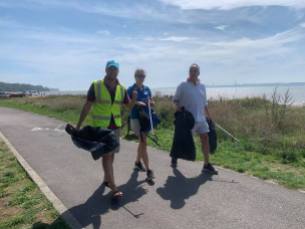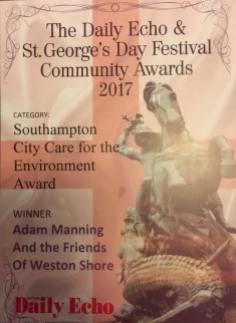By Adam D.A. Manning
This is the text used for a talk given to the Friends of Southampton Museums, Archives and Galleries and to the Hound Local History Society.
My talk is entitled “Reflections on Weston Shore” and what I want to do is share some of the richness connected with part of our beautiful city of Southampton, as a way of demonstrating how much there is to learn and enjoy.
I’m the Chairman of the Friends of Weston Shore, a local community group that looks after Weston Shore. That’s why I’ve been asked to give this talk today, to share some of what we’ve learned and why we love the place so much.
Now, here I am getting carried away but of course it maybe that some of you don’t know what, exactly, I’m referring to by the name of “Weston Shore”, or even if you have heard of it, you may have never actually been there. We’re always surprised, if not to say a bit bewildered, to come across people who have lived in Southampton for years, for their whole lives, and never been to Weston Shore or even heard of it. Perhaps in part that’s because it happens to be on the eastern half of the city, across that great divide of the River Itchen that bisects Southampton like an impassable canyon.
For those that don’t know, it’s a refreshingly open area of grassland and a pebble shore on the eastern side of Southampton, overlooking Southampton Water and opposite Hythe. Being the shore at Weston in Southampton gives it its name. To get there from here, go straight across the Itchen Bridge, through Woolston and then head to the shore next to Weston Parade. Nice and easy!
For the purposes of my talk today, I’m going to define Weston Shore as the stretch of coast from Southampton Sailing Club to the west to Netley Castle in the east. Let’s start by looking at the history of the area.
Weston Shore’s History
Archaeologists have found lots of evidence of the area being inhabited going back as far as prehistoric times as far back as the Stone Age, from finds of worked flint tools and burnt brick earth, that is clay used to make bricks. Interestingly, there is less evidence for later prehistoric settlement, but some Iron Age finds suggest the area continued to be used throughout.
Similarly, evidence, albeit limited in nature, has been found indicating the area was occupied during the Roman Empire, between 43 A.D. and 410 A.D., including hoards of coins found during the 19th century in Westwood (the large wood to the north of the shore) and the area now known as the Royal Victoria Country Park. Further archaeological evidence has yielded other finds, suggesting that Weston Shore continued to be used throughout this period. Southampton’s Roman settlement was named Clausentum, and its location, though not known for certain, is often taken to be roughly where Bitterne Manor Community Centre is today.
It’s generally accepted that for hundreds of years, until really the early decades of the twentieth century, the shore at Weston was used by the small fishing communities in the area. The earliest dates for the use of the name of Weston for the area is from the tenth century.
The biggest nearest settlement at that time to Weston Shore would have been Olaf’s Tun. Tun is the old English word from which we get town. The Olaf referred to here is King Olaf I of Norway, who lived from around 960 A.D. to 1000 A.D, and he established a fortified tun on the eastern shore of the River Itchen which is today known as Woolston. This was a time, it has to be remembered, when it is alleged that the Danes, or Vikings as we sometimes call them, ravaged and ruled these lands, including our city of Southampton, which at that time was called Hamwic or Hamtun, or sometimes South Hamtun. Hamtun later gave its name to Hamtunscire, the name for the county, which became our word Hampshire.
By the time of the Domesday Book of 1086, Olaf’s Tun was being called Olvestune, and Lateleie (or Netley) and Westune (Weston) are recorded as well. Weston Shore during this time appears to have fallen with the Manor of Woolston. Archaeological evidence concerning Weston Shore is fairly scarce for this period, but it seems likely the area would have been marshland and the foreshore would have been used for grazing, hunting and fishing and the shore would have been a major access point for local fishermen.
This fishing heritage is highlighted by an important item in Weston Shore’s heritage, that of the Seaweed Hut. This large, ramshackle looking building, which always looks to me as though it was somehow grown or arisen naturally from floatsam on the beach, was a sight on the shore for centuries, dating as it does back to at least the seventeenth century and possibly long before that. This extraordinary structure must have been a sight and it existed until 1967, so I only just missed being able to see it. It was originally built by fishermen and had piles driven into the ground to protect the walls, with transverse beams of oak to support the roof.
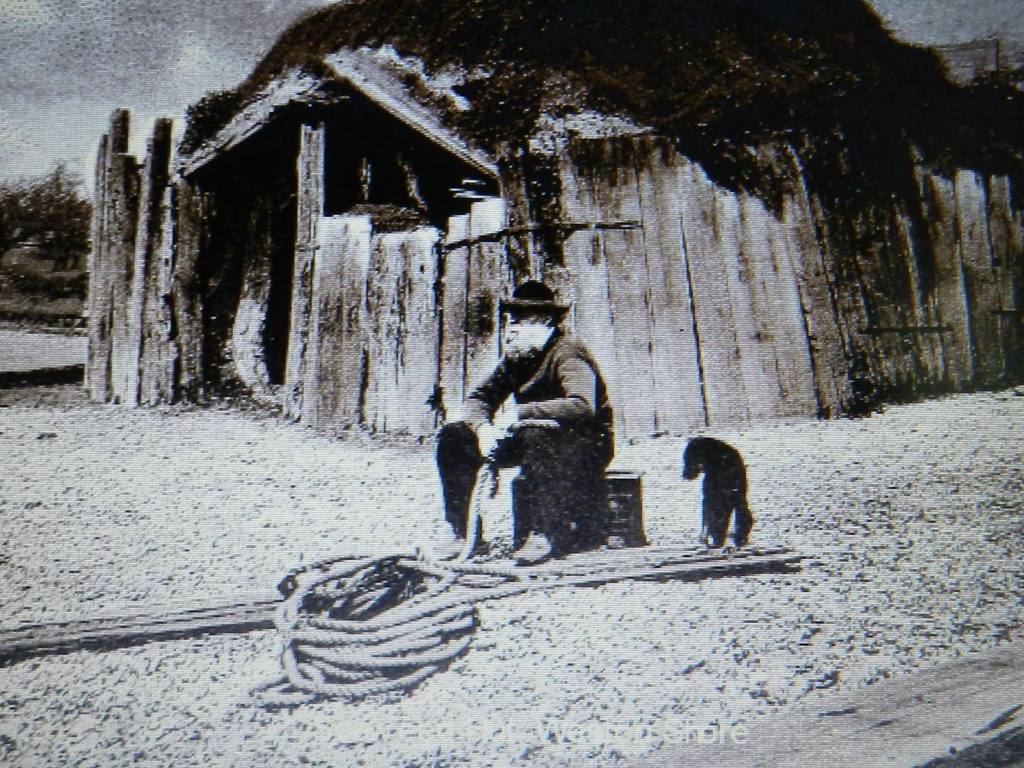
Apparently, the main body of the hut was made from Seaweed itself, hence the name, probably bladderwrack, matted so closely together that it became smooth. As you might imagine, it had to be renewed every once in a while, and it was used to store fishing gear before there were proper roads in the area and as a shelter and meeting point. Although it was still being used well into the twentieth century, by 1967 it had become neglected and had to be demolished. As a child, I used to regularly hear about it and it is still fondly remembered, and every once in a while, there are suggestions that a new version should be built. Although it is long gone, remains of it can still be found around 30 centimetres below the surface.
A rather grander building in the area is Netley Castle, which is situated at the eastern end of Weston Shore. This was built on the site of a previous artillery fort built by Henry VIII in either 1542 or 1544 to protect Southampton Water, after the dissolution of the monasteries, which of course had a very serious effect on nearby Netley Abbey. Indeed, some material was taken from Netley Abbey, particularly the gatehouse, to build the original Netley Castle, or Netley Fort as it was called then. Apparently, there is even an existent tunnel running underground from Netley Abbey to Netley Castle.

The Castle was part of a nationwide programme of coastal fortification by King Henry as a response to perceived threats from France and the Holy Roman Empire. After Henry’s break from the Roman Catholic Church, the Pope had encouraged these two countries to attack or even invade England and these forts were a response to that threat. You will recall that Henry’s break with the Pope was because he wanted his marriage to Catherine Aragon annulled, which the Pope would not hear of. Catherine Aragon was the Aunt of Charles V, the Holy Roman Emperor, and when the annulment was finally affected, Charles V took it as a grave personal insult. Invasion therefore seemed quite possible.
Netley Castle’s original design was rather like that of Southsea Castle, which would have been different from what we see today. Interestingly, there is a reference from 1627 to Netley Castle being called “Westoun Fortress”.
After the English Civil War and the restoration of the monarchy in 1660, the Castle was abandoned and by around a hundred years or so it had fallen into ruin and was overgrown. In 1826, a certain Mr William Chamberlayne inherited it, Chamberlayne being a name that is difficult to avoid running into regarding land and properties in the area. For around a hundred years, the Castle was in private hands and generally rebuilt to become a home, in a restrained, gothic style. Netley Castle is sometimes, perhaps unfairly, referred to as a folly, or pretend Castle, as a result. Around the start of World War 2 until almost the end of the twentieth century, it was used as a nursing or convalescent home. In 2000, it was refurbished at great expense, albeit in a satisfyingly sympathetic manner, and then sold as private flats.
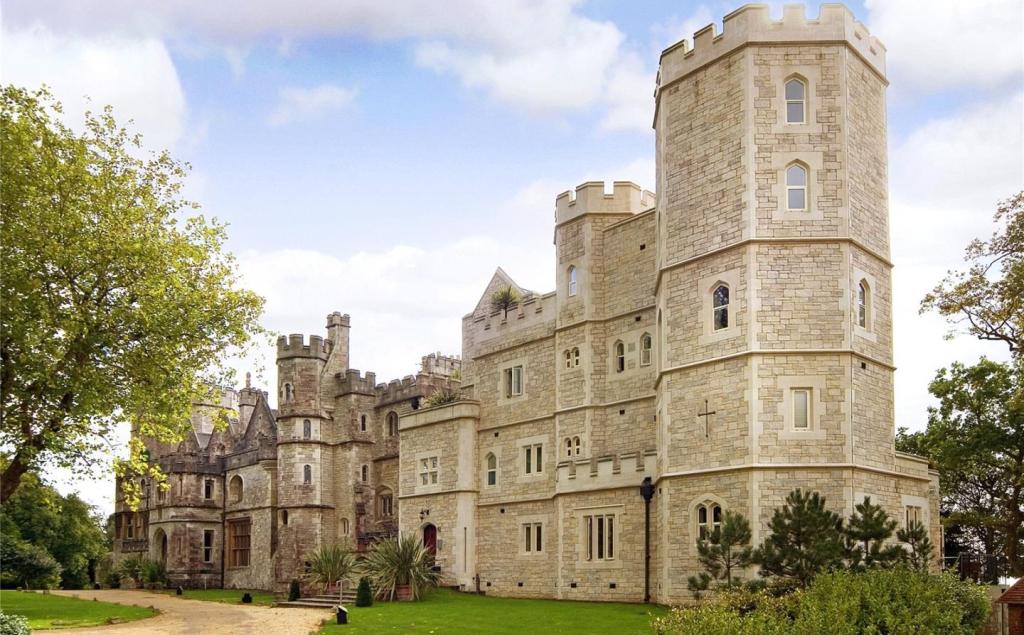
I grew up over the road from Netley Castle on Abbey Hill in Netley. The Castle is situated in one corner of a beautiful park called the Conkerfield and seeing the tower of the Castle jut out above the trees marking the boundary of the Conkerfield is a wonderful sight. Indeed, it is possible that the Conkerfield is the remains of the grounds serving Netley Castle. This is deduced because many of the larger trees in the Conkerfield have wide open canopies, suggesting that they did not grow up in crowded woodland that exists around them now. Interestingly, despite being within the boundaries of Eastleigh Borough, the Conkerfield is owned privately by Southampton City Council, presumably as a result of the transfer of Netley Castle to Southampton Area Health Authority in 1945.
The Conkerfield, with Weston Yacht Club in another corner, is one of my favourite places and the park is divided from the shore there by a path, which is shielded from the sea by a stone wall. This path was originally a long road that provided access to Netley Castle and you can imagine people traversing it on horseback in all weathers. Part of the wall was smashed during a storm over Southampton Water a few years ago; it shows the power of the wind and waves that a wall that stood for hundreds of years can be broken in one night.

The name of William Chamberlayne, a major landowner in the area during the late eighteenth and early nineteenth centuries, also features when we consider another interesting building, sadly long since demolished, at the other end of Weston Shore. William Chamberlayne was descended from Count John de Tankerville, who had arrived in England with William the Conqueror. Count John’s family were the hereditary chamberlains, that is the manager of a nobleman’s household, of the Dukes of Normandy and ultimately, he took the surname of Chamberlayne as a result.
In 1799, this William Chamberlayne inherited from his father a vast estate including land in both Berkshire, Leicestershire and Hampshire. The land in Hampshire included both sides of the River Itchen and as a Solicitor, I have dealt with properties all over our area, including Eastleigh for example, in which this family name is prominent in the title deeds. Part of his inheritance included an estate named Weston Grove, roughly in the same area as Mayfield Park today. In 1801, he built a marine villa on this estate, called Weston Grove House. The precise spot seems to have been to the west of Archery Road and south of Swift Gardens. The house and its grounds drew praise. For example, a frequent visitor to the house wrote that,
“”To those who like water-scenes (as nineteen-twentieths of people do) it is the prettiest spot, I believe, in all England. … the views from this place are the most beautiful that can be imagined. You see up the water and down the water, to Redbridge one way and out to Spithead the other way. Through the trees, to the right, you see the spires of Southampton, and you have only to walk a mile, over a beautiful lawn and through a not less beautiful wood, to find, in a little dell, surrounded with lofty woods, the venerable ruins of Netley Abbey, which make part of Mr. Chamberlayne’s estate.”

This house certainly looks impressive and one can only imagine how lovely it must have been on a summer day, looking out from it down towards Southampton Water.
A local landmark connected to William Chamberlayne that still exists today is the Portland Stone obelisk that stands in Mayfield Park. He built this in 1810 as a memorial to his friend Charles James Fox. At one point, the obelisk, which was built on the highest point in the estate where a windmill had once been, was visible from Woolston and indeed Obelisk Road in Woolston is named for that observation. Weston Grove Estate was renamed Western Lawn in 1830.
It seems that despite this high praise, William Chamberlayne did not spend a great deal of the time there and the mansion was often let to tenants. After the start of World War 1 it seems to have been left unoccupied and was ultimately demolished in 1940. Western Lawn Estate was ultimately, roughly speaking, divided up between what is now Mayfield Park and the housing estate in Weston.
Another part of the Weston Grove Estate near the shore was the Rolling Mills in the large flat area of land situated where the Pitch & Putt Course is today. This was built on part of the Weston Lawn Estate, part of the estate owned by the Chamberlayne family during the middle of World War 1. At first it was a steel-rolling mill, which gave it its name, but soon the building was used to manufacture cupro-nickel (or brass) strip for the manufacture of cartridges, that is for small calibre shell cases. This building was remarkably half a mile long and later during World War Two it was converted to a Royal Navy stores until it was ultimately closed in 1987. The site was extensively cleaned up and then became a housing estate, whilst some of it was left as open ground on which many people today walk their dogs. Part of the boundary wall of the Rolling Mills still survives today though.
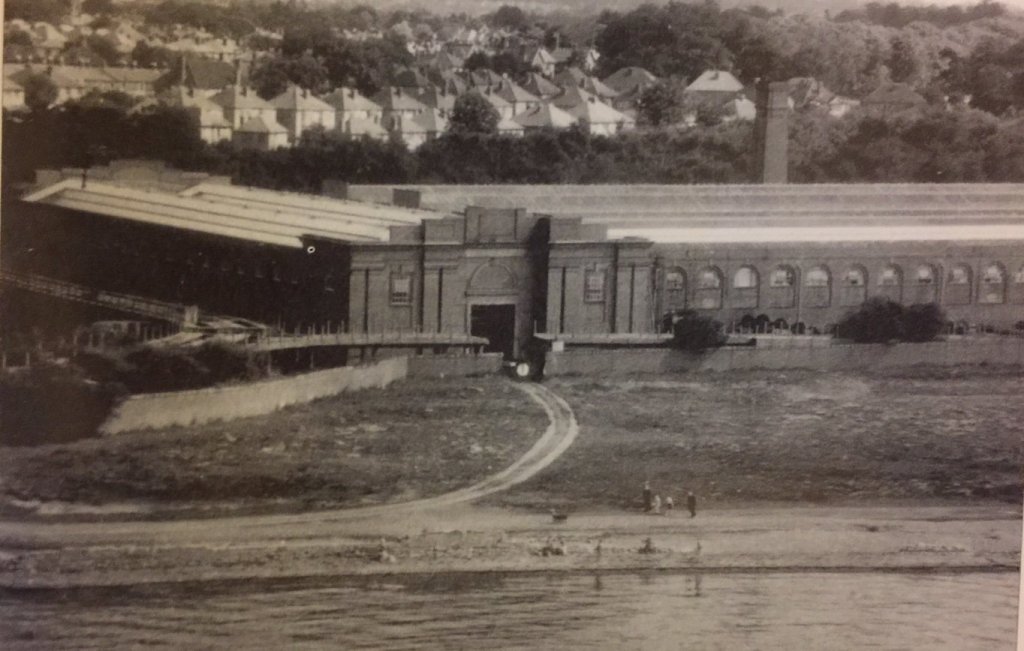
During World War One, many of the workers at the Rolling Mills were women, and the following is from an interview with a woman who worked there, who reminisces about the conditions;
“When I went for a job at the Woolston Rolling Mills I was asked if I would be able to drive a crane. As I’d come straight from boarding school I said I wouldn’t know until I tried; so I was taken up and shown the controls. I had someone with me twice, after that I was left to myself.”
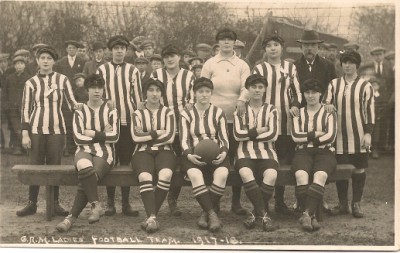
“The day I started at the Rolling Mills it was bitterly cold. They hadn’t finished the roof or walls and snow was coming in. So we spent the day huddled over a brazier to keep warm. I was so ill when I got home I didn’t think I’d ever go back, but my mother gave me a glass of brandy and I was fine the next day.”
“We had to see a doctor once a month, that was the girls who were working in the foundry, because there were fumes and we had to wear masks. We were allowed a pint of milk a day, and all our clothes supplied. We used to have two hours up and two hours down, we had to rest, you see.”
“We had to remove hairpins, jewellery, and outdoor shoes and anything which might strike a flash.
“The factory floor was always wet to minimise any spark which no doubt might cause an explosion.”
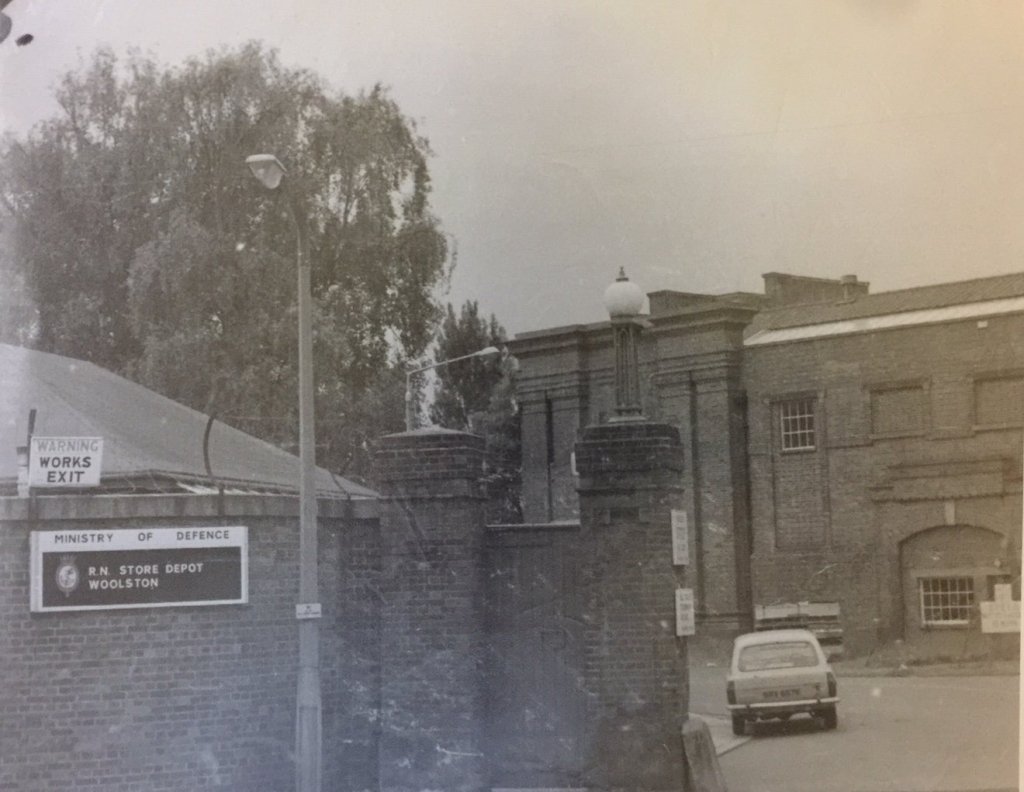
Weston Shore itself was also a scene of activity in the build up to D-Day during World War Two. It was closed to the public and saw lots of troops, equipment and landing craft being co-ordinated in both the build up to the day itself and the re-supply operation. In particular, contingents of American and Canadian soldiers were encamped on the shore.
When we consider Weston Shore itself, the increasing urbanisation of Weston and Woolston lead many people to think of the shore as a place of relaxation and enjoyment, just as we do today. During the 1920s a promenade was constructed along the shore, edged with a dwarf wall on one side, for ease of use for visitors to the area.
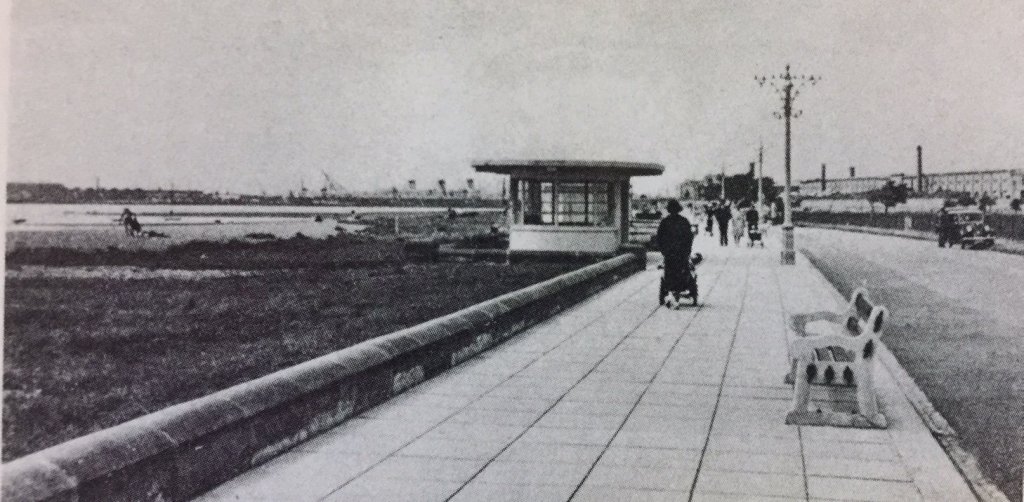
In the mid 1930s, four Shelters with ovoid roofs, in a modernist or Art Deco style, were constructed on the shore for the benefit of visitors and have stubbornly remained there ever since. The promenade and the shelters constitute the primary built environment on Weston Shore and so the main structure given to the shore appears to have changed little for the best part of a century as a result. Their longevity has lead to them being familiar and recognised elements of the local landscape, giving rise to lots of memories for local people in the area.
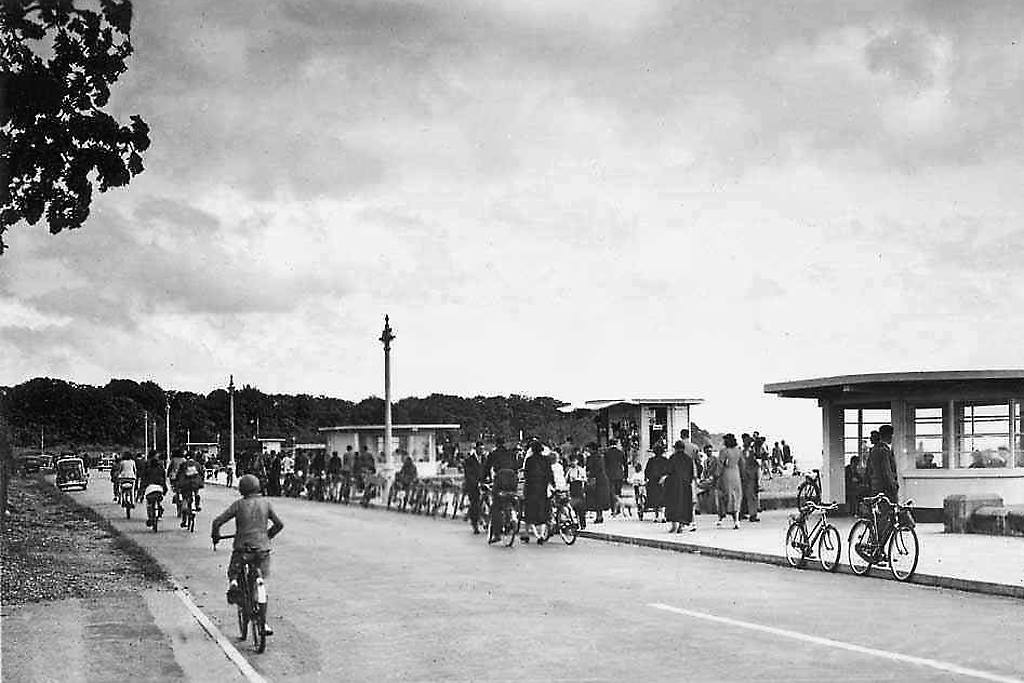
After a long period of neglect, the shelters were refurbished at great expense with the additional of extra artwork slightly more than ten years ago. This coincided with a lot of work to improve the shore and an exciting project by an environmental public artist named Abigail Downer. The latter included a large art installation of the image of a diatom (a microalgae, a type of phytoplankton) on the large open area in front of the tower blocks in 2006. A lot of this work involved contributions from local people and represented a major investment in the area. The group I belong to, Friends of Weston Shore, also saw its genesis during this period.
To conclude this whistle-stop historical tour – what’s comforting is that thousands of years later, people are still regularly fishing at Weston Shore today.
The Wildlife of Weston Shore
Of course, Weston Shore is a habitat for wildlife as well as an attractive spot for people to visit. It is an important site for wildlife in the Southampton area, particularly as it is one of the few significant sections of reasonably “natural” shoreline in Southampton, along with the rather harder to reach Chessel Bay Local Nature Reserve, further up the River Itchen near Bitterne, especially in terms of access for visitors and local people.
The shore itself along with the inter-tidal area (that is the mudflats visible at low tide) were designated a Site of Special Scientific Interest in 1992. These areas subsequently became incorporated within the Southampton Water Special Protection Area (SPA) and the Solent and Southampton Water RAMSAR site. The RAMSAR designation relates to the Convention on Wetlands of International Importance especially as a Waterfowl Habitat that was signed in the Iranian city of Ramsar in 1971. These protections largely relate to the inter-tidal area’s importance as a habitat for migratory birds and so the area is protected at both a national and international level.
At Friends of Weston Shore, we’ve been keen to learn more about the wildlife on the shore. Whilst the area is busy with visitors, there’s also an attractive natural aspect to the area and its clear that lots of different types of plants and animals make it their home. We wanted to find out more about this and we contacted an ecologist from the Southampton Natural History Society called Phil Budd in this regard. In 2015, the Friends of Weston Shore, with the use of money from a grant, commissioned him to provide us with a report on just what, exactly, was to be found in our area. There have been previous studies, but none were very up to date or particularly comprehensive. He looked an area from the Rolling Mills and Woolston Jetty up to the Conker Field at Netley and included everywhere inland to the edge of West Wood and International Way at Weston.
Phil’s study indicated the presence of 958 species of plant, fungi, animal, bird and invertebrates in his survey. This is broken down to 163 birds, 156 insects (including 21 species of butterfly) and about 75 marine species on the shore, 338 flowering plants and 185 other plants and fungi. This is an impressive total in itself but Phil modestly notes that this is probably only a sample of what can be found on Weston Shore, especially as there are likely to be far more insect types to find on Weston Shore.
Obviously, there’s not time to talk about every species to be found on the shore but here are some highlights. Phil has found a colony of the attractive Bee Orchid at one site within the survey area along with two other flowering plants that had not been seen for many years, that being the Slender Hare’s-Ear (not seen for ninety years) and the Rough Clove (not seen for forty years). The 71 species of lichen that Phil has recorded included the Golden-Eye Lichen, which was once thought to be extinct in the UK!
The 163 species of birds include many common gulls, waders and water birds. Well known visitors to the shore include Oystercatchers, curlews and, my own favourite, the Little Egret. Sometimes severe storms bring in rarities such as the American Bonapart’s Gull (seen in 2015), the Sabine’s Gull, Leach’s Storm Petrel and the Grey Phalarope.
Storms can also bring interesting cast-ups of marine wildlife including Grey Triggerfish and the Goose Barnacle. Grey seals and Common seals are being seen with increasing regularity off the shore and one of the ice-cream sellers who regularly attend at Weston Shore tells me he sees a seal once in a while, playing amongst the waves.
Insects seen at Weston Shore include a colony of the rare Wood Cricket and some interesting butterflies such as the Clouded Yellow and the Small Heath. The sea purslane on the shore can be a habitat for coneheads, a type of small grasshopper.
Phil’s report, copies of which are available, makes it very clear just what a rich habitat for nature Weston Shore is. It’s exciting to note that in recent years, other wildlife organisations have given the area increasing recognition. This has included the Marine Conservation Society, who carry out an annual survey of litter on the shore as part of their programme of activities. Last year, the shore played host to a wonderful Sea Life Discovery Day with Hampshire and Isle of Wight Wildlife Trust. Here, experts from the Trust spent the day examining the wildlife on the shore to find out more, in the company of members of the public.
Capturing Our Coast, a new project aimed at discovering more about our marine life, was also in attendance. There long-term aim is a survey of all the wildlife on our coastlines and so its great news that Weston Shore forms part of their survey.
Weston Shore is also regularly visited by our friends at Bird Aware Solent. As the name suggests, they are particularly interested in the numerous bird species on our coastline. As well as surveying them, they are concerned about ensuring the birds’ survival. Their particular concern is minimising disturbance of our wild birds in their habitat. It has to be remembered that as wild creatures, birds such as curlews and dunlin are living on a knife-edge of energy use from the food they obtain in the wild. When we disturb birds, for example out for a walk with the dog, and they fly off, this can quickly lead to them having an energy deficit which has serious implications for their survival.
Personally, I’ve adored learning more about all this and my own revelation that has stayed with me is the way a piece of seaweed or a shell can itself be a habitat for a number of other species.
Inspiration for Literature
It’s not surprising that a beautiful place like Weston Shore can inspire beautiful words. Ancasta by Diana Jackson is set in the local area, with characters living in Woolston and Netley. Set before and then during World War One, the novel takes its name from the Celtic Goddess of the same name who was worshipped during Roman times. She is mentioned on an altar inscription from Clausentum, the Roman settlement in Southampton mentioned earlier, and it is possible she may have been a goddess associated with the River Itchen, possibly the goddess of the River Itchen.
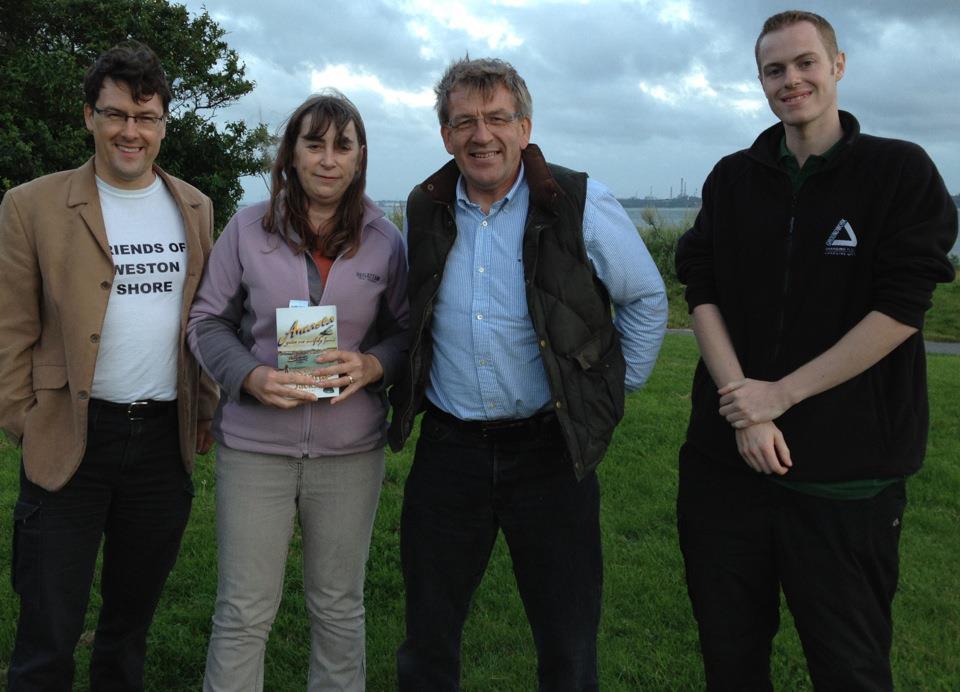
This votive dedication is now in the Sea City Museum. Ancasta as a name possibly derives from an old Proto-Celtic word, Kasto, meaning swift, which suggests an association with the river. As with much of what we think we know about the past, especially the distant past, this is somewhat speculative.
Ancasta, the novel, concerns itself with the lives of several families who are, without giving away any spoilers, utterly traumatised by the events of World War One. To them, walks along Weston Shore provide an escape, a sanctuary from the terrible events that war unleashes on them and the shore plays a role in their lives that is not too dissimilar to how many people use it now – for relief from life’s woes and a chance to breathe fresh air and see the waves. It is a touching and engaging novel that I have no hesitation in recommending and is one volume in a series by the author.
Weston Shore and the 21st Century
What’s striking on reflection is the amount of different uses that Weston Shore is put too in our contemporary times. The predominant theme, as with the twentieth Century, is that of leisure and recreation. As it has been for centuries, it is a wonderful place to walk and take the air and pedestrians can either enjoy striding across the pebble beach or marching up and down the promenade, or (as I suspect most people do) a bit of both. Sunbathers and people who just want to relax can lie back and rest whilst dog walkers can give their canine friends a treat to roam and run.
Other more energetic pursuits including cycling along the shore or running its length and the shore is part of both cycle ways and running circuits. There’s also a regular contingent of kite landboarders during the summer months; that is using an oversized skateboard attached to a parachute to take off into the air! This is distinguished form kitesurfing, which is a similar activity but takes place over the water. Jet skiing is also a popular past time for some during the summer, often using the slope near the Pitch and Putt Course to gain access to the water. And of course, the Pitch and Putt Course, reopened in recent years, provides diversions all of its own and is great fun.
The shore is annually the scene for the regatta for Southampton Rowing Club, which by some twist of fate, always seems to fall on the same day that we have our annual walk along the shore. This usually results in witnessing scenes in which Sarah Killworth, our wonderful secretary, admonishes the rowers to ensure they do not leave their litter on the shore afterwards.
Sailing is a very important leisure use of the water, for both the members of Weston Yacht Club and Southampton Sailing Club. So, the area is well served for sailing pursuits. Surf boarders also have a long history of enjoying the waves, and sometimes the water itself!
As well as enjoying the beautiful views of the sea, shore and sky and the plants and animals at the shore, people often come to Weston Shore to enjoy watching the cruise liners sail in and out of Southampton docks. I’m not overly interested, but even I have to sometimes stop and marvel at them, especially when such huge vessels turn and change direction in the middle of Southampton Waters. They are so large, they look less like ships of the sea than huge spaceships, their huge mass lying on or even above the waves. If there happens to be a combination of say two or three or more of these huge ships on the water at a time, people congregate from far a-field to gaze as they slip by, gracefully and calmly sliding by despite their gargantuan bulk.
As mentioned before, fishing, as it always has been, is a key interest for many people who visit the shore and the fishermen are regularly there in all weathers, sometimes holding competitions on the shore.
Weston Shore has always been attractive for children, to enjoy running across the pebbles, gazing at the sea and even the occasional paddle. In the middle of the area is a Pirates’ Playground that is used and loved by families all year long.
Weston Shore is part of the Weston Shore Link, which links the shore as a walking and cycling path past the stream that cross underneath the road at the bottom of Abbey Hill, past the Lodge, the beautiful little cottage recently refurbished, past Weston Yacht Club and then over the Conkerfield and onto Netley Abbey and finally onto the Royal Victoria Country Park. Quite a walk!
It’s also part of a much longer sequence of a 60-mile footpath, from Milford on Sea in the west to Emsworth Harbour, passing along much of the Hampshire coastline. Weston Shore is rather in the middle of this walkway, which is referred to as the Solent Walkway.
In conclusion, the shore is already being used for a wide range of activities and this is likely to increase with the addition of new people and families to the immediate vicinity as a result of all the new buildings in the area, with the development of Woolston.
Friends of Weston Shore
Almost finally, I would like, if I may, to say a few words about our Friends group, the Friends of Weston Shore. We’re a small but happy band, who regularly get together to do what we can to protect and promote our beautiful beach.
Our origins date back to the middle of the nineties when a few of us first got together to help clean up the shore. Starting small, the litter and rubbish in those days was very badly entangled in the undergrowth and soil. And it was everywhere. My memories of Weston Shore, growing up in the 70s and 80s, was a place of neglect – it was the butt of many local jokes. Stolen cars were regularly driven into the pebble banks on the shore or left in the car parks and set on fire.
That historical perception of abuse, misuse and abandonment was something we wanted to tackle. I have a distinct memory of uncovering a very old, broken Lucozade bottle with the price, I am sure, in the old money of 2 and 6. We regularly found bits of old cars and after a while I was sure we had recovered enough to build our own. Some people would scoff and jeer once in a while, but most people were very supportive.
Our litter picks then were only once a year or so but steadily grew bigger and bigger, especially once we discovered the idea of letting people know about them through a letter to the Echo. We always a lot of help and encouragement from our friends at Southampton City Council and by the late 2000s the beach clean ups had got so large that they prompted us to formalise the group into a “Friends” group with a written constitution and a bank account, to ensure the longevity of the project.
We first formally came into existence as a “Friends” group in 2009 and our activities have continued to centre on litter picking and trying to keep the beach as clean as possible. Every year we have an annual Big Beach Clean Up on the shore, during the summer in which we invite members of the public to get involved, along with two or three smaller clean ups just for us. Litter picking quickly becomes something of a compulsion, and so we often have a group walk along the shore, just to enjoy the beauty of the place and make a conscious effort to leave our litter pickers behind!
Our litter picks have been getting bigger and bigger and typically we expect to see fifty to sixty people at them, although the two most recent ones have both involved over seventy people. This was because we were joined by volunteers from the Surfers Against Sewage, from the Student Union at Solent University and the Marine Conservation Society of the University of Southampton.
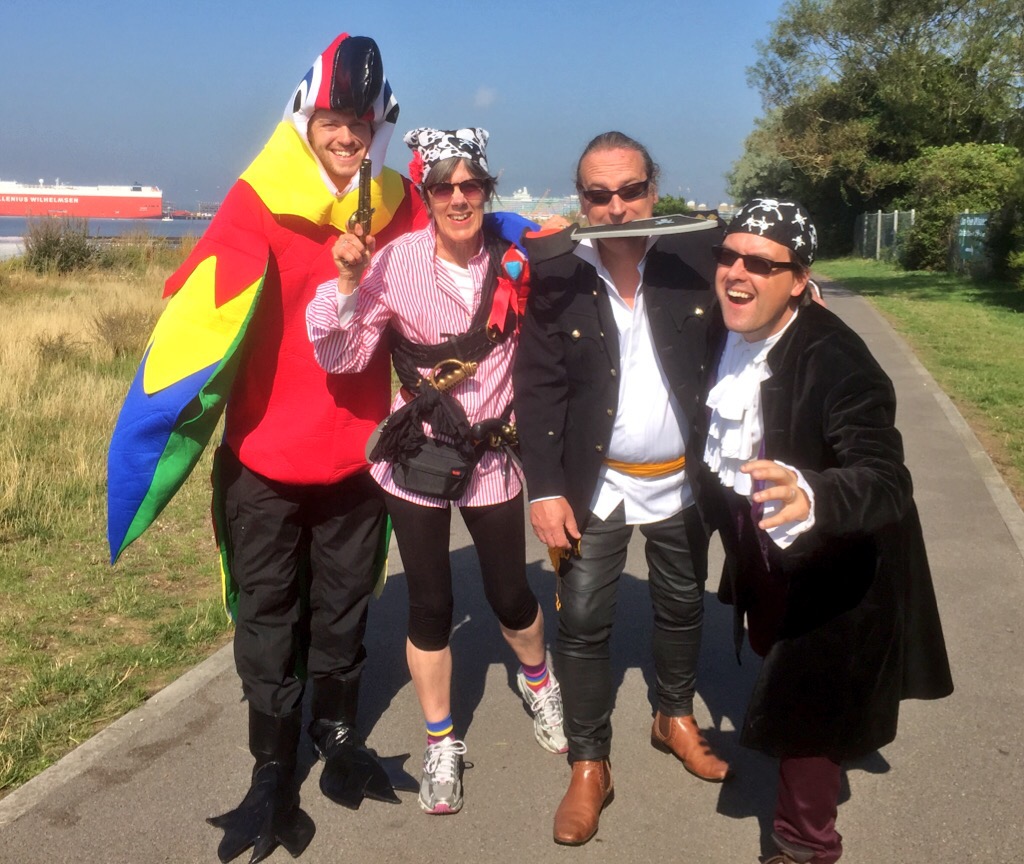
Litter picking has become a much more widespread activity than when we first began operations and its easy to see why. A lot of people want to get involved and put their energy into an activity that really helps and litter picking, and beach clean ups offer that in a very clear, simple to understand way. Many people have become aware of the enormous problem of litter and in particular plastic debris on our beaches. Not only is it unsightly and significantly diminishes our enjoyment of the natural world (or at least the great outdoors), it can be devastatingly dangerous for wildlife. Mice can fall into drink cans and never be able to get out. Ring pulls for drinks cans can deform or strangle wildlife. David Attenbrough’s Blue Planet 2 series has really energised people’s interest in this issue.
The benefits of litter picking are immediately obvious. It’s wonderful to look back and see an area that you and your friends have worked on looking beautiful and clean – and it doesn’t take that long to make a difference.
The beach, we like to think, has become cleaner over the years and a big part of this is through the ceaseless efforts of our hero, Richard Evans, who is very regularly, almost every day it seems, at the shore cleaning up the litter. Richard’s equipment, including the trolley he uses, are made from reused, or upcycled as we like to say, bits and pieces that he has found on the shore. He is a source of a lot of information about the wildlife and geography of the area and he is an inspiration for us in what we do.
In sympathy with the litter picking, the Friends of Weston Shore have been keen to learn more about the wildlife to be found on the shore and as well as the report we commissioned from Phil Budd, Phil has also been guiding us on walks up and down the shore. These are always a delight – there really is a lot of joy in learning more about the nature in your area.
As the beach is now cleaner than in previous years, one of our aims with the litter picks is to engage families with children and encourage them to participate. Having children myself, it is only too clear to me how quickly they grow up. We believe it is important to interest them at a young age in these sorts of issues so that they grow up with knowledge and experience of them in their background in the hope that they will continue to develop their involvement in the future.
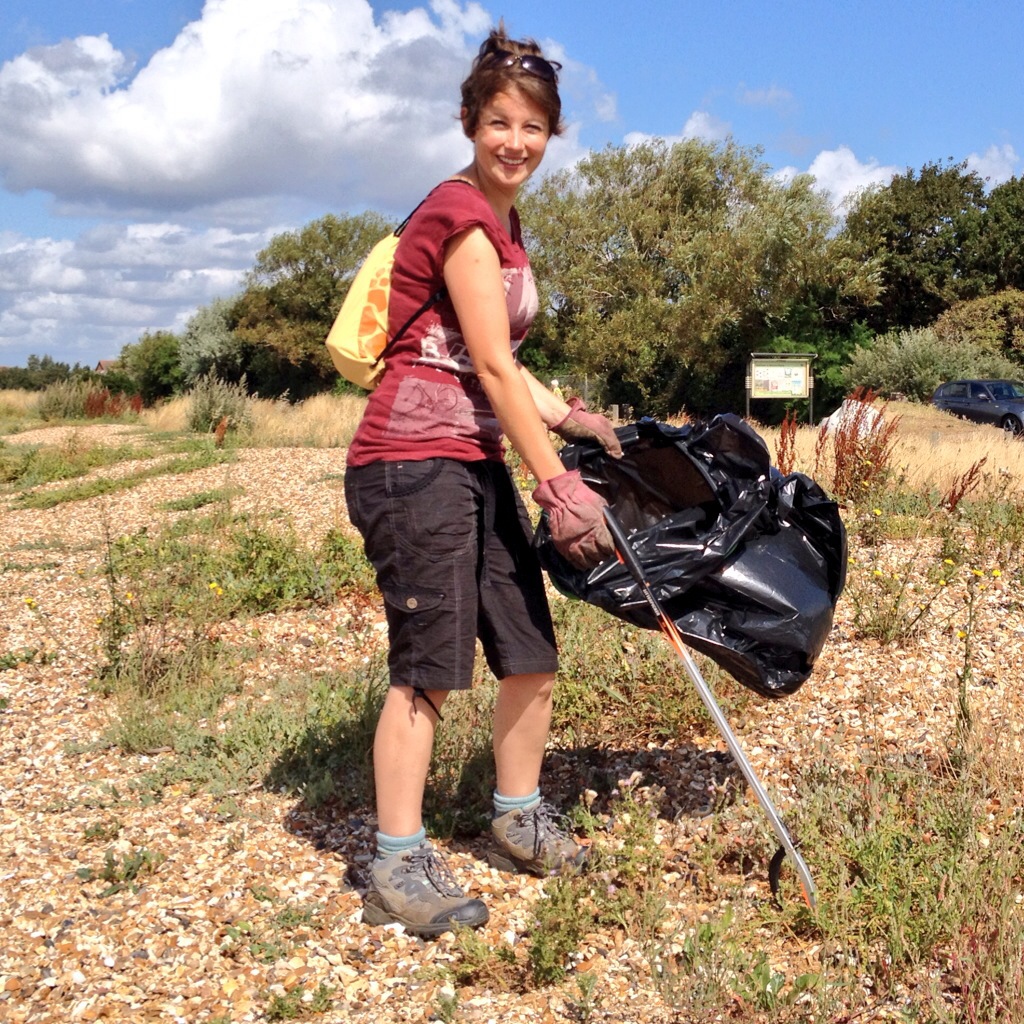
Part of our plan in doing so is to give the litter picks a fun theme. Our chosen them has been the classic adoption of pirates, that is the golden age of pirates, and we have been dressing up and giving the event a pirate theme as a result. We have pirate treats to give to children taking part in the beach clean, along with information about the wildlife on the shore. In recent years, we were awarded a grant to develop educational packs aimed at children that included spotters guides to the birds, plants and other wildlife on the shore, as well as games and pens and crayons, and even a toy magnifying glass.
As an aside, with our pirate theme we focus this on a historical pirate, so there’s an educational element there too! This is Robert Reneger, Southampton’s very own historical pirate, who interestingly sets the precedent for the later Golden Age of Piracy.
A pirate from Southampton, he was from an earlier age than the Golden Age of Piracy and was active during the first half of the sixteenth century. Towards the end of the reign of Henry VIII In 1545 (around the time of the building of Netley Castle), Reneger captured a Spanish treasure ship called the San Salvador. This was in revenge for the Spanish taking from him a French ship he had captured before. Captain Reneger and his crew took the booty from the treasure ship, which included lots of gold and sugar, back to England where it was stored in the Tower of London.
Captain Reneger was given a hero’s welcome for this and was promoted by the King to commander of the fleet. All of this infuriated the Spanish especially as England had previously made an agreement with them to stop their attacks on Spanish shipping. This was one of the incidents that set the scene for the privateers and the later Golden Age of Piracy and the many attacks on Spanish ships by the English.
The Friends of Weston Shore are delighted to revive the memory of Captain Reneger, who is incorporated into our yearly Pirate fun day at the playground on Weston Shore. If anyone knows anymore about Captain Reneger please get in touch!
Whilst there is no direct link, as far as we know, relating Captain Reneger to Weston Shore (although he must have sailed by it at some point), there is a story involving Netley Castle and piracy. One of the first Captains of Netley Castle was a man called Sir Henry Ughtred, who became Captain there at some point in the 1570s. Following a complicated dispute with William Paulet, his brother-in-law who had become the owner of Netley Castle, in 1580, Sir Henry built a 500 ton galleon with a crew of 150 that was later accused of raiding Portugese and Spanish shipping, including some of the first recorded incidents of piracy near Newfoundland in North America. Another Southampton pirate!
Our future plans include developing the information obtained in our Wildlife Survey Report into leaflets, posters and other formats for people to enjoy and read. The beach clean ups will always form the central focus of our efforts but another long-term goal is to assist in a project to refurbish the various amenities found on the shore.
In recent years, we’ve also worked extensively with other organisations and companies, such as the HSBC and Royal Bank of Scotland and the Environment Agency in facilitating their Corporate Social Responsibility Policies, enabling them to hold litter picking events on the shore. This has been a really effective part of our strategy in keeping the shore as clean as possible.
In April 2017, we were honoured to receive the Southampton City Care for the Environment Award at the City Award’s ceremony at Solent University. Whilst we don’t do this for recognition, to have some was a really wonderful surprise, for which we are very grateful.
We’re always hoping that new volunteers will make contact with us and come along and help out however much they can. Pirate costume is purely optional…
And Finally…
Ladies and gentlemen, my hope is that this talk has made clear how rich a place like Weston Shore is and how much there is to learn and enjoy. To those that know it, it’s a very important, cherished place and that’s certainly how we feel about it in the Friends of Weston Shore.
Being involved in our beach clean ups has been a great source of satisfaction to me. To look back at an area after you and your friends have cleaned it up and see it looking pristine and beautiful again is a wonderful feeling. With a few friends, it doesn’t take long to make a significant impact in this way.
More profoundly, there is a sense of identity in a place such as Weston Shore. When you enjoy a place, when it is somewhere you love and makes you happy, it can become a powerful part of your sense of self. You have lived some of your life there, and it has become an important element of your personal history. Special places, such as the Conker Field to me, can be the location for our happiest and most joyful times that make life worth living.


